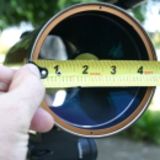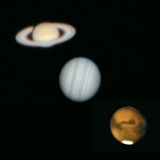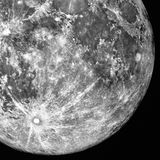
What do you do on a sunny day? Chances are you slip a pair of polarized sunglasses over your eyes. They cut down glare and appear to make colors, such as a cobalt-blue sky, look snappier.
Backyard astronomers do the same thing when they thread eyepiece filters into a telescope eyepiece to, say, cut the Moon's glare or bring out cloud bands on Jupiter. Eyepiece and telescope filters improve the view. And in the case of solar observing, they actually provide a safe way to look at the Sun directly.
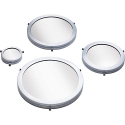 Solar Filters
Solar Filters
Solar filters come in two main varieties: metal-coated black-polymer film and glass. In both instances, it's a metal alloy electrostatically applied to a surface that filters out the Sun's blinding intensity and harmful infrared radiation. Glass solar filters typically slip over a telescope's front aperture to block the light before it enters the scope. Film solar filters can be found in rolls or sheets of material that is wrapped around the front of a telescope, and more deluxe versions can have a plastic filter cell specially fitted for the front aperture of the telescope.
By some measures, glass solar filters offer greater durability than foil-like black-polymer film. On the other hand, black polymer can take an occasional drop on the ground without worry of cracking or shattering, like glass. The type of metal coating applied to black polymer film makes the Sun appear blue or neutral-white, while the coating on glass solar filters yields a more realistic yellow image.
Solar filters designed to fit a telescope eyepiece should be avoided. They are extremely dangerous because they sit right where the sunlight is most concentrated (focused). Remember burning dried leaves with a magnifying glass when you were a kid? Well, likewise, the heat that builds up at the eyepiece will eventually cause the filter to crack, which can permanently damage your eyes. If you come across a filter like this, get rid of it. See our handy solar filter reference chart to find the right solar filter for your telescope or pair of binoculars.
 Moon Filters
Moon Filters
Believe it or not, you're also dealing with bright, albeit reflected, sunlight when you turn your scope on the Moon. A noncrescent Moon will consistently leave spots even in a hardened lunar observer's eyes, although this will not damage your eyes.
To tone down the glare, a Moon filter can be used. This inexpensive accessory threads into a telescope eyepiece and blocks a large percentage (typically over 80%) of the light, making for more comfortable viewing and bringing out more lunar surface details.
A variable-polarizing Moon filter is a little fancier, allowing you to "dial in" the amount of light reduction you want. In so doing, it acts as something of a dimmer switch for your telescope. Such variable-polarizing filters actually consist of two polarized filters mounted in a rotating housing, which you turn to adjust the brightness. Double star observers often use variable polarizers to distinguish, or enhance, tightly paired targets that sometimes smear together in each other's light.
![]() Planetary (Color) Filters
Planetary (Color) Filters
Backyard observers also utilize an array of color eyepiece filters to glean subtle features on the planets. Earth's atmosphere is in constant fluctuation; turbulent air currents blur fine surface detail on solar system objects, like planets, viewed through a telescope. Faint, contrasting areas blend together due to irradiation - distortion of the boundaries between light and dark areas. Using color eyepiece filters can help reduce such distortion.
A color filter zeros in on a narrow region of the spectrum, reducing the scattering of interfering wavelengths. Because many planets have a characteristic color (e.g., Mars is reddish), a filter can dramatically increase detail by reducing the predominant hues and uncovering hidden contrast and surface markings. That's why the Red Planet is most effectively enhanced with a green filter. Each color eyepiece filter passes its characteristic color of light while blocking complementary colors. For example, green objects will appear bright (pale) through a green filter, and dark through a blue or red filter. Red features will appear bright through a red eyepiece filter and dark through a green or blue eyepiece filter.
Telescope eyepiece filters thread into the barrel of an eyepiece. Usually the aluminum cell holding the filter is threaded such that two or more can be "stacked," to achieve simultaneous filtering of more than one color.
 Color filters go by their "Wratten" numbers. Here is a rundown of the color eyepiece filters that are useful for enhancing detail on each planet and some other objects.
Color filters go by their "Wratten" numbers. Here is a rundown of the color eyepiece filters that are useful for enhancing detail on each planet and some other objects.
Mercury
#25 Red will make the planet's disk stand out against a blue sky, permitting daytime or twilight viewing. Mercury is usually best observed just after sunset, when the sky is awash in orange light, so employ #21 Orange with high magnifications to see the planet's phases.
Venus
No matter what telescope aperture you use, Venus's excessive brightness usually causes a very "overexposed," roiling image. With a #47 Violet filter, or stacked #58 Green and #80A Medium Blue filters, you'll reduce the severe twinkling for a better view of the fascinating changing phases.
Mars
#25 Red passes the predominant reflections of surface plains and maria, and #21 Orange is good for reducing the intense glare to enhance detail and mottling. The polar caps stand out with #15 Deep Yellow and #80A Medium Blue; examine the melt lines with #58 Green.
Jupiter
This great planet reveals its cloud bands, loops, festoons, ovals, and Red Spot with #80A, #58, and #21. Go from seeing only two bands without a filter to seven or more with a filter! Try stacking filters to reduce the heavy glare.
Saturn
Many subtle details are improved by #15 Deep Yellow. See the difference in brightness of the extremes of the rings with #25, #58, or #80A. The #15 filter also helps sharpen Saturn's image in photographs, improving the resolution of the Cassini division.
Moon
Reduce the Moon's glare with #80A Medium Blue, and enhance the contrast of lunar rilles and strata with #15 Deep Yellow.
Other Uses
You will improve black-and-white photographs by blocking UV light with #15 Deep Yellow filter. Refractor chromatic distortion is also reduced by #15, and by #80A filters. The #82A Pale Blue filter is great for stacking with other colors, and can adjust film color balance by absorbing excess yellow and red. #58 Green will block street light while passing much of the wavelength of doubly ionized oxygen in emission nebulas. Try #25 Red for long black-and-white exposures of the Omega or Rosette Nebulas.
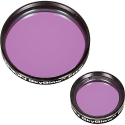 Deep-Sky Filters
Deep-Sky Filters
One very useful weapon in the fight against light pollution is a light-pollution filter. So-called broadband filters, like the Orion SkyGlow, effectively block the wavelengths of light generated by incandescent, sodium, and mercury-vapor lights, which brighten the evening skies in cities and suburbs, while letting through the desirable wavelengths emitted by galaxies and emission nebulas (hydrogen alpha, hydrogen beta, and oxygen III). This type of eyepiece filter is also popularly called a light-pollution-reduction, or LPR, filter. Bright, light-polluted skies appear much darker, and the contrast between object and sky is improved significantly.
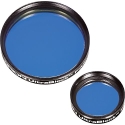 Narrowband eyepiece filters, such as the Orion UltraBlock, allow an even narrower range of wavelengths through. This type of eyepiece filter is often called a "nebular filter" because it is particularly effective in enhancing detail and contrast of emission and planetary nebulas. Galaxies and reflection nebulas don't benefit much.
Narrowband eyepiece filters, such as the Orion UltraBlock, allow an even narrower range of wavelengths through. This type of eyepiece filter is often called a "nebular filter" because it is particularly effective in enhancing detail and contrast of emission and planetary nebulas. Galaxies and reflection nebulas don't benefit much.
Narrowband eyepiece filters block all forms of light pollution, including wavelengths from incandescent and fluorescent lighting, which broadband filters cannot stop. So they are effective in areas with severe light pollution. They will transform a poor, milky-sky urban backyard into something useable for deep-sky observing.
Still, their effect is most dramatic under a truly dark sky.
Other deep-sky eyepiece filters are "tuned" with bandpasses intended for the light of specific targets. Oxygen III, or O-III, filters are optimized for planetary nebulae. H-beta eyepiece filters convey the blue-green luminescence of faint emission nebulae like the Horsehead or California Nebulas. And comet filters permit the passage of light given off by, of all things, glowing cyanogen gas that surrounds comets.
So, thanks to a whole battery of eyepiece and telescope filters we can see things that run the gamut from sunspots to the shattered remains of an exploded star. If you enjoy even a moderate amount of observing, you will benefit by having a few filters at your disposal. Chances are, you will reach for an eyepiece filter at night as often as you reach for sunglasses on a sunny day.
They almost always improve the view!


